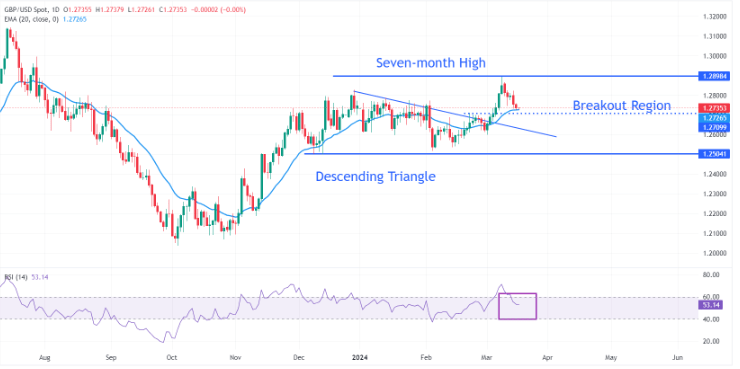- The Pound Sterling remains range-bound as market participants await key events including UK inflation data and the Bank of England’s (BoE) policy decision for updated cues.
- Market consensus anticipates the BoE to uphold interest rates unchanged, given that UK inflation remains significantly below the 2% target.
- The trajectory of the US Dollar will be influenced by the Federal Reserve’s dot plot, which will provide insights into future interest rate expectations.
In Monday’s European session, the Pound Sterling (GBP) grapples with indecision as investors adopt a wait-and-see approach ahead of crucial interest rate decisions from both the Federal Reserve (Fed) and the Bank of England (BoE), slated for Wednesday and Thursday, respectively.
Anticipation surrounds the BoE’s likely decision to maintain interest rates at 5.25%, given that inflation exceeds the desired 2% target. Market participants are particularly interested in the BoE’s guidance on interest rates, seeking clues regarding the duration of the high interest rate regime.
Presently, market expectations point towards the BoE commencing interest rate reductions in its August policy meeting. However, policymakers have emphasized that rate cuts will only be deemed appropriate if there is substantial confidence in inflation sustainingably rising to the 2% target.
The BoE faces the challenge of balancing high inflation against the backdrop of uncertainty surrounding economic growth. The UK economy experienced a technical recession in the latter half of 2023, marked by contraction in the last two quarters. Although January saw a modest 0.2% growth, this figure alone does not suffice to confirm a return to growth for the economy in the entirety of the first quarter.
Daily digest market movers: Pound Sterling awaits UK Inflation for fresh guidance
- The Pound Sterling maintains a narrow trading range near 1.2730, displaying weakness as investors shift their attention to impending monetary policy decisions from both the Federal Reserve and the Bank of England.
- The Fed is anticipated to keep interest rates unchanged within the range of 5.25%-5.50%. Investors eagerly await insights from the dot plot, reflecting policymakers’ rate expectations over time. Notably, December’s dot plot projected three rate cuts for the year, but recent stubbornness in consumer and producer inflation may prompt revisions. Should the Fed project fewer rate cuts, the US dollar’s appeal could strengthen. The US Dollar Index (DXY) has commenced the week with muted trading, hovering around 103.45.
- Across the Atlantic, the Bank of England is also expected to maintain interest rates at 5.25% for the fifth consecutive time. However, the battle against inflation in the United Kingdom persists, with wage growth momentum far surpassing the necessary levels to curb inflation to the 2% target. Among the nine policy committee members, MPC member Swati Dhingra is anticipated to advocate for a rate cut decision.
- Ahead of the BoE’s announcement, the Pound Sterling will be influenced by the release of the Consumer Price Index (CPI) data for February, scheduled for Wednesday. Forecasts indicate a deceleration in the annual core CPI to 4.6% from January’s 5.1%, while the monthly headline CPI is expected to show growth of 0.7% following a 0.6% decline in January.
- Soft inflation figures may heighten expectations of a rate cut by the BoE in the August policy meeting, while strong data could dampen such expectations.
Technical Analysis: Pound Sterling drops to 20-EMA near 1.2730

The Pound Sterling oscillates around the 1.2730 mark against the US Dollar. A correction in the GBP/USD pair has led it to the vicinity of the 20-day Exponential Moving Average (EMA) near 1.2730, driven by an expanding disparity with spot prices. Potential support lies near the breakout zone of the Descending Triangle, approximately at 1.2700. Conversely, on the upside, Pound Sterling bulls may encounter significant resistance at a seven-month high near 1.2900.
The 14-period Relative Strength Index (RSI) has reverted to the 40.00-60.00 range, indicating a sharp contraction in volatility.
